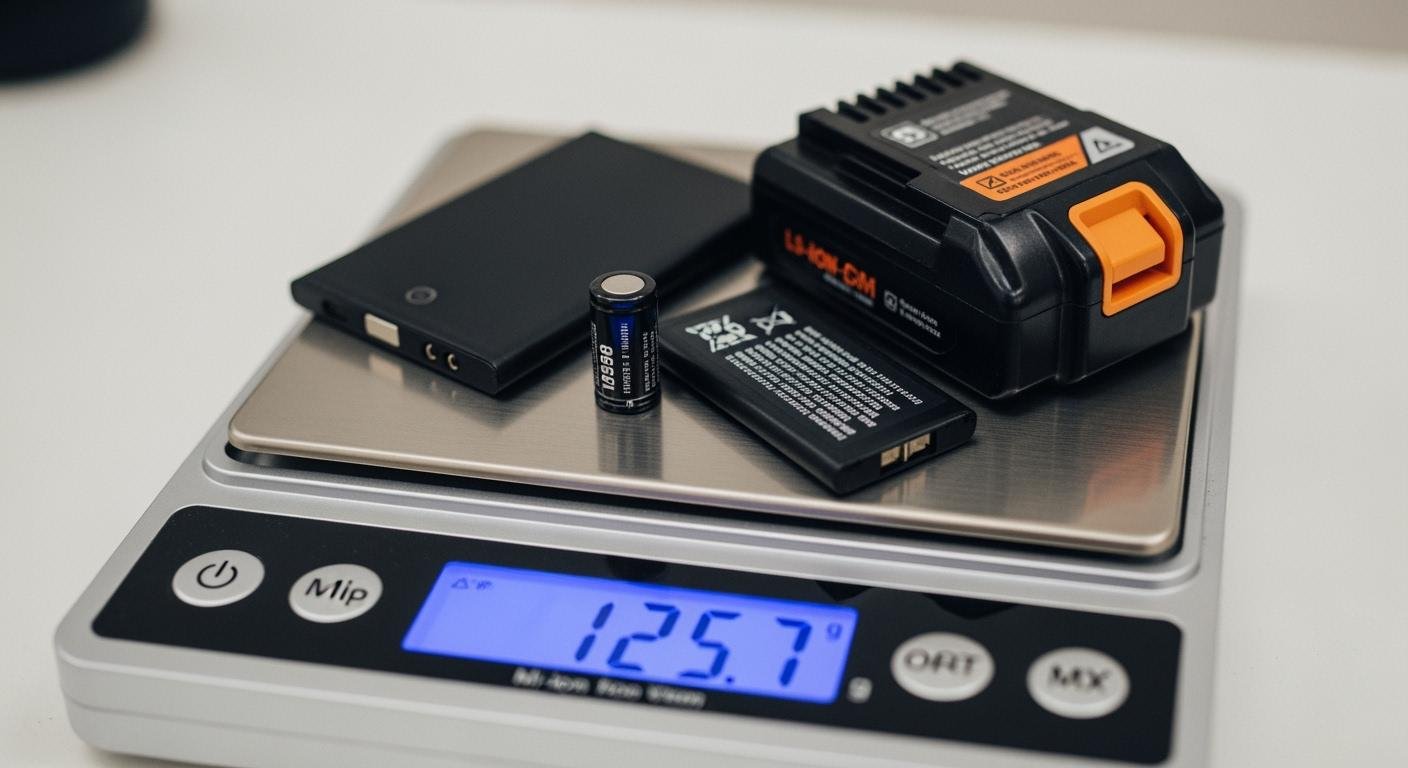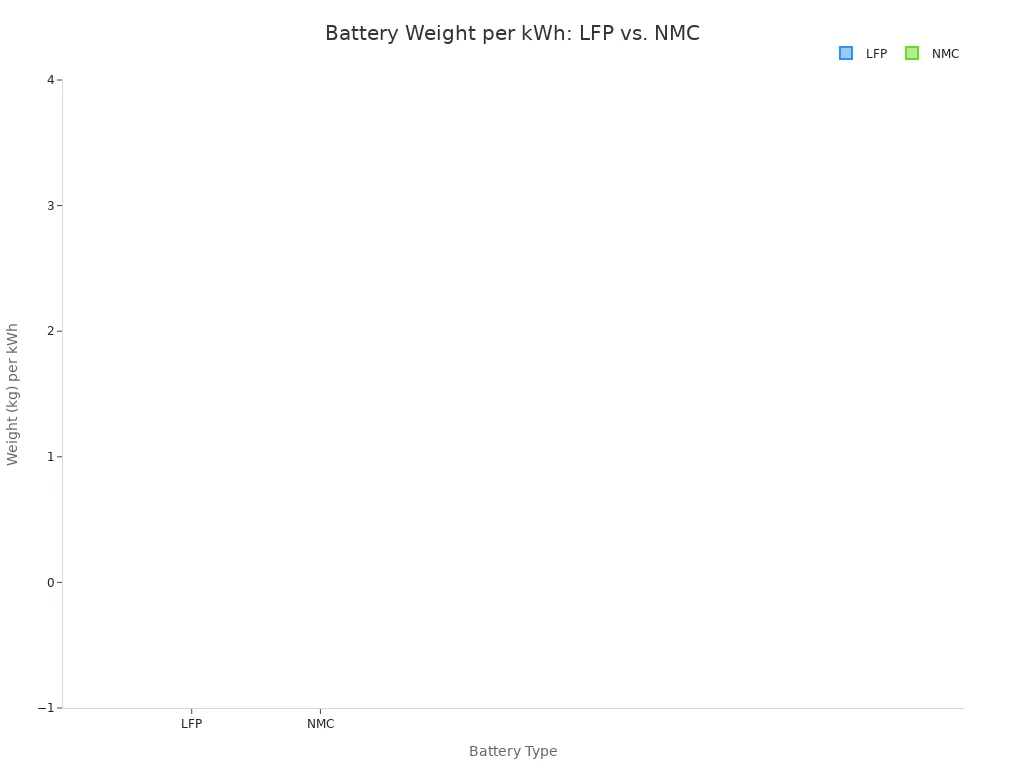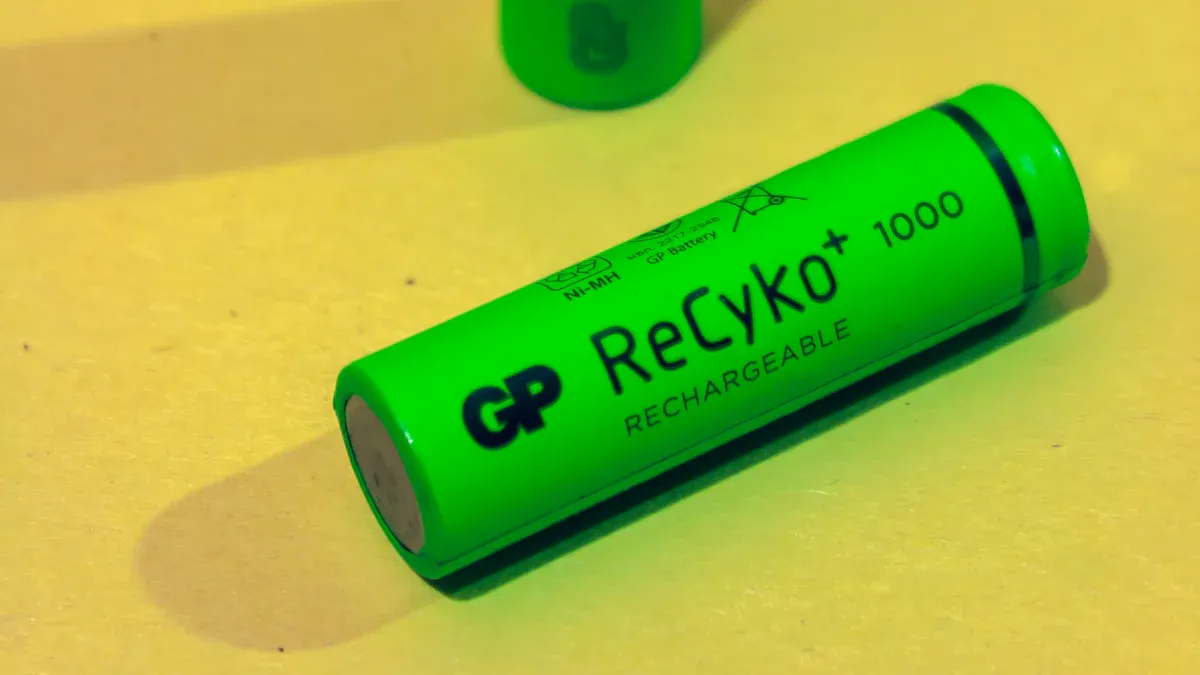
Calculating the weight of li-ion batteries starts with a core formula: Battery Weight = Total Energy / Energy Density. Two factors primarily determine the lithium-ion battery weight: the total battery capacity and the battery’s chemistry, which sets its energy density. The energy density of a commercial lithium-ion battery typically has an energy density of 150–250 Wh/kg; this energy density is a crucial value. A higher energy density in a lithium-ion battery means a lower battery weight. The final battery weight includes significant mass from packaging, increasing the total battery weight. The energy density of any lithium-ion battery is a critical factor for the overall battery weight, as this energy density directly impacts the final battery weight of the lithium-ion battery. The high energy density of a lithium-ion battery is what makes this energy density so important, and this energy density varies by chemistry.
How to Calculate Your Battery Weight
Estimating the weight of a lithium-ion battery is straightforward with the right information. The process involves a core formula and a few key steps. This guide provides the tools for an accurate battery weight calculation.
The Core Calculation Formula
Engineers determine battery weight using a simple principle. The weight is directly related to the total energy stored and the battery’s energy density. A higher energy density means less weight is needed to store the same amount of energy.
The primary formula uses energy in Watt-hours (Wh):
Weight (kg) = Capacity (Wh) / Energy Density (Wh/kg)
An alternative formula is useful when capacity is known in Amp-hours (Ah):
Weight (kg) = Capacity (Ah) × Nominal Voltage (V) / Energy Density (Wh/kg)
Note: These formulas calculate the weight of the battery cells only. The final battery weight will be higher after adding the protective casing and electronic systems.
A Step-by-Step Estimation Guide
Users can follow a simple four-step process to estimate the final battery weight. This method provides a realistic figure for most applications.
- Determine Required Energy (Wh): First, identify the total energy the device needs. This is usually measured in Watt-hours (Wh).
- Find the Energy Density (Wh/kg): Next, find the energy density for the chosen lithium-ion battery chemistry. This value typically ranges from 150 Wh/kg to 250 Wh/kg.
- Calculate Cell Weight: Use the core formula to calculate the combined weight of the battery cells.
- Add System Weight: Increase the calculated cell weight by 30-40% to account for the casing, electronics, and cooling systems. This gives a good estimate of the total battery weight.
Let’s see this in action with a few examples.
Example 1: Consumer Drone 🚁
A delivery drone might need a 4S lithium-ion battery with a capacity of 74 Wh to complete its mission. If the battery uses cells with an energy density of 200 Wh/kg, the cell weight calculation is:
Cell Weight = 74 Wh / 200 Wh/kg = 0.37 kgEstimated Final Battery Weight = 0.37 kg * 1.35 (35% markup) = 0.50 kg
The final battery weight for this drone would be approximately half a kilogram.
Example 2: Electric Scooter 🛴
Electric scooters have a wide range of energy needs. A scooter with a 400 Wh battery pack offers a good balance of range and weight. Assuming a mid-range energy density of 180 Wh/kg for its lithium-ion battery:
Cell Weight = 400 Wh / 180 Wh/kg = 2.22 kgEstimated Final Battery Weight = 2.22 kg * 1.35 (35% markup) = 3.0 kg
The battery pack for this scooter would contribute about 3.0 kg to its overall weight. Typical scooter battery capacities vary by intended use.
| Scooter Type | Daily Range | Typical Battery Capacity (Wh) |
|---|---|---|
| Short-Range Commuters | Under 10 mi | 250–350 Wh |
| Long-Range Commuters | 20+ mi | 500 Wh+ |
| High-Performance | 45+ mi | 775 Wh+ |
Example 3: Portable Power Station 🔋
Portable power stations are designed to store large amounts of energy. A medium-sized unit might have a 1000 Wh capacity. If it uses a lithium-ion battery with a durable but lower energy density of 160 Wh/kg:
Cell Weight = 1000 Wh / 160 Wh/kg = 6.25 kgEstimated Final Battery Weight = 6.25 kg * 1.30 (30% markup) = 8.13 kg
The battery weight alone for this power station is over 8 kg. The high energy density of a different lithium-ion battery could reduce this weight.
| Power Station Size | Capacity Range (Wh) |
|---|---|
| Small | 100-500 Wh |
| Medium | 500-1500 Wh |
| Large | 1500-3000 Wh |
| Extra Large | 3000 Wh+ |
Accounting for Packaging and Systems
The 30-40% weight increase comes from essential non-cell components. These parts protect the lithium-ion battery, manage its performance, and ensure safety. The added mass is significant and cannot be ignored for an accurate battery weight estimate.
Key components contributing to the non-cell battery weight include:
- Enclosure: This is the outer casing that protects the battery pack. It can be made from materials like steel, aluminum, or lightweight thermoplastics. The choice of material impacts the final battery weight.
- Battery Management System (BMS): This electronic system monitors cell health, manages charging, and ensures the lithium-ion battery operates safely.
- Thermal Management System: This system regulates temperature to maintain optimal performance. It can include cooling channels, thermal plastic trays, aluminum cooling plates, and thermal interface materials, all of which add to the battery weight.
These structural and electronic systems are critical. They ensure the reliability and safety of the lithium-ion battery but also increase its mass beyond the cells alone. A higher energy density helps offset this additional battery weight. A low energy density will result in a heavier pack. The specific energy density of the cells is therefore a crucial factor.
Factors Affecting the Weight of Li-ion Batteries

Several key battery weight factors determine the final mass of a lithium-ion battery. The most important are energy density, chemical composition, and total energy capacity. Understanding these elements is crucial for estimating the weight of li-ion batteries accurately. A change in any of these factors can significantly alter the final battery weight.
The Role of Energy Density
Energy density is the most critical metric influencing battery weight. It measures how much energy a lithium-ion battery can store for a given size or mass. There are two types of energy density to consider:
- Gravimetric energy density (Wh/kg): This measures energy storage per unit of mass. A higher gravimetric energy density means a lighter battery for the same amount of energy. This is the key factor for the overall battery weight.
- Volumetric energy density (Wh/L): This measures energy storage per unit of volume. A high volumetric energy density allows for a more compact battery.
Higher gravimetric energy density in cells directly reduces the overall battery weight of a pack. This advantage is vital for applications like electric vehicles. Reduced battery weight improves driving range, acceleration, and handling. A lighter lithium-ion battery can also lower a vehicle’s center of gravity, which enhances stability. In portable electronics and robotics, a better energy-to-weight ratio enables more agile movement and longer operational times. The gravimetric energy density is therefore a primary driver of battery performance. The volumetric energy density is also important for fitting the battery into a device. High gravimetric energy density and high volumetric energy density are both desirable. Excellent gravimetric energy density leads to a lower battery weight. The volumetric energy density affects the physical size. Good gravimetric energy density is essential for lightweight designs. The volumetric energy density dictates how much space the battery occupies.
How Chemistry Impacts Weight
The chemistry inside a lithium-ion battery cell dictates its gravimetric energy density. Different chemical makeups offer trade-offs between energy density, cost, safety, and lifespan. This choice directly impacts the lithium-ion battery weight.
Nickel Manganese Cobalt (NMC) batteries are a popular choice for applications where low weight is critical. NMC chemistry offers a high gravimetric energy density, typically ranging from 150–260 Wh/kg. This allows for more energy storage in a lighter package. Advanced cells from manufacturers like CATL, Panasonic, and Samsung SDI push this even further, with some achieving a gravimetric energy density over 300 Wh/kg.
In contrast, Lithium Iron Phosphate (LFP) batteries have a lower gravimetric energy density. LFP cells typically range from 90–160 Wh/kg, though newer versions are reaching up to 205 Wh/kg. Their lower energy density means they are heavier for the same amount of energy. However, they offer benefits like longer cycle life and improved safety. The choice between NMC and LFP often comes down to balancing battery weight against other performance needs. The volumetric energy density of NMC is also generally higher than LFP. This means an NMC lithium-ion battery is both lighter and smaller. The volumetric energy density difference is significant for compact devices.
The table below compares these common chemistries and shows how their energy density affects the battery weight per kilowatt-hour (kWh).
| Chemistry Type | Average Energy Density (Wh/kg) | Example Weight per kWh (kg) |
|---|---|---|
| LFP (Lithium Iron Phosphate) | 90–160 Wh/kg | 6.3–11.1 kg |
| NMC (Nickel Manganese Cobalt) | 150–260 Wh/kg | 3.8–6.7 kg |
| NCA (Nickel Cobalt Aluminum) | 200–265 Wh/kg | 3.8–5.0 kg |

The chart clearly illustrates that for the same energy storage, an LFP battery will have a greater battery weight than an NMC battery. This makes NMC a better choice for weight-sensitive applications. The volumetric energy density follows a similar trend.
Energy Capacity and Mass
A battery’s total energy capacity and its mass are directly related. The relationship is defined by the gravimetric energy density formula.
Battery Weight (kg) = Total Energy (Wh) / Gravimetric Energy Density (Wh/kg)
This formula shows that for a fixed energy density, increasing the total energy storage requires more active material. This directly increases the battery weight. A larger battery capacity will always result in a heavier lithium-ion battery, assuming the chemistry remains the same. The weight of li-ion batteries scales almost linearly with capacity.
For example, a lithium-ion battery generally weighs between 6 and 8 kg per kilowatt-hour (kWh). This value can change based on the specific cell chemistry and pack design. High-performance electric vehicles often use cells with a very high energy density to minimize the lithium-ion battery weight and maximize battery performance. The volumetric energy density is also a key consideration in vehicle design. A high volumetric energy density helps fit a large battery into the car’s chassis.
The following table provides real-world examples of battery weight per kWh.
| Application / Battery Type | Weight per kWh (kg/kWh) |
|---|---|
| Lithium-ion battery (general) | 6–8 kg/kWh |
| Tesla Model S 85 kWh pack | ~6.35 kg/kWh |
| Nissan Leaf 40 kWh pack | ~7.6 kg/kWh |
These figures highlight how pack design and cell choice influence the final battery weight. A higher energy density allows manufacturers to reduce the battery weight, which is a constant goal in product development. The volumetric energy density is equally important for efficient packaging.
A Breakdown of Lithium-ion Battery Weight

Understanding the total weight of li-ion batteries requires looking at two levels: the individual cell and the complete battery pack. Each level adds mass from different components. The final battery weight is a sum of all these parts. A good battery pack design aims to minimize this added weight.
Inside a Single Battery Cell
A single lithium-ion battery cell contains several key parts. The cathode is the heaviest component. In a standard 18650 cylindrical lithium-ion battery, the cathode makes up about 44% of the cell’s total mass. Its high weight comes from active materials that store energy. A higher energy density in the cathode material leads to a better overall energy density for the cell.
Cathode Materials The cathode’s chemistry determines the cell’s performance and energy density. Common materials include:
- NMC: Nickel Manganese Cobalt
- LFP: Lithium Iron Phosphate
- NCA: Nickel Cobalt Aluminum
The other major components of a lithium-ion battery also contribute to its mass. The anode, electrolyte, and separator are essential for function but are lighter than the cathode. The cell’s casing provides protection. In cylindrical cells, the steel casing can account for more than a quarter of the battery weight. This casing adds significant mass without improving the energy density. The choice of materials directly impacts the cell’s energy density and the final lithium-ion battery weight. A higher energy density is always a goal.
Components of a Lithium-ion Battery Pack
A battery pack contains many individual cells plus several other systems. These systems add considerable battery weight. The enclosure houses everything and protects the lithium-ion battery. Manufacturers use materials like aluminum or engineered plastics for the enclosure. The battery pack design must balance protection with minimizing battery weight.
The Battery Management System (BMS) is a critical electronic component. It monitors the lithium-ion battery and ensures safe operation. A BMS itself has weight; for example, some units weigh around 0.1 kg.
Cooling systems are also vital for managing heat in a lithium-ion battery, which affects performance and energy density. Common cooling methods include:
- Phase-changing material (PCM)
- Liquid-assisted cooling
- Hybrid systems
Each system adds to the total battery weight. A complex liquid cooling system will increase the lithium-ion battery weight more than a simple air-cooled battery pack design. The overall energy density of the pack is lower than the cell’s energy density because of these non-energy-storing parts. A high cell energy density helps offset this, but the final battery weight always includes these essential systems. The energy density of the lithium-ion battery pack is a key metric.
Understanding the weight of li-ion batteries is essential for many projects. A higher energy density in a lithium-ion battery reduces the overall battery weight. The final lithium-ion battery weight depends on its energy density and capacity.
Key takeaways include:
- A battery’s chemistry directly impacts its energy density and battery weight.
- The total battery weight includes cells plus 30-40% for systems.
- A higher energy density means a lighter lithium-ion battery.
Remember the core formula for a quick estimate:
Battery Weight (kg) = Capacity (Wh) / Energy Density (Wh/kg)
Choosing the right lithium-ion battery involves trade-offs. LFP chemistry offers excellent safety and a long lifespan of 3,000-6,000 cycles at a lower cost. However, its lower energy density increases the lithium-ion battery weight. NMC chemistry provides a higher energy density for a lower battery weight but has a shorter lifespan and higher cost. The specific energy density of a lithium-ion battery is a critical factor. A high energy density is key for lightweight designs, while a lower energy density may be acceptable for stationary applications.
FAQ
Why is energy density so important for battery weight?
A high energy density allows a lithium-ion battery to store more power in less mass. This high energy density directly reduces weight. A better energy density means a lighter product. The specific energy density is the most critical factor for weight, while the volumetric energy density affects size.
Does a higher battery capacity always mean a heavier battery?
Yes, a larger battery capacity requires more active materials. This directly increases the weight of the lithium-ion battery. For a given chemistry, doubling the energy storage will roughly double the cell weight. The energy density and volumetric energy density remain constant for that chemistry.
How does volumetric energy density differ from gravimetric energy density?
Gravimetric energy density (Wh/kg) measures energy per mass. A high energy density here means a lighter battery. Volumetric energy density (Wh/L) measures energy per volume. A high volumetric energy density creates a smaller, more compact lithium-ion battery. Both are important design factors.
What makes one lithium-ion battery heavier than another?
Chemistry is the main reason. Different chemistries have a different energy density. A low energy density results in a heavier battery for the same power. The volumetric energy density also varies. Pack design, including the casing and cooling systems, adds extra weight. A better energy density helps offset this.

